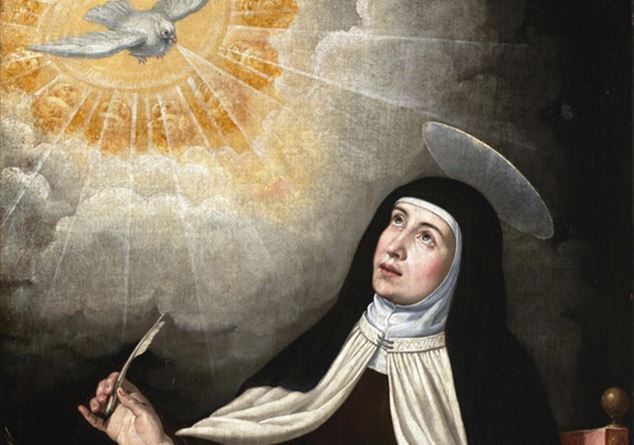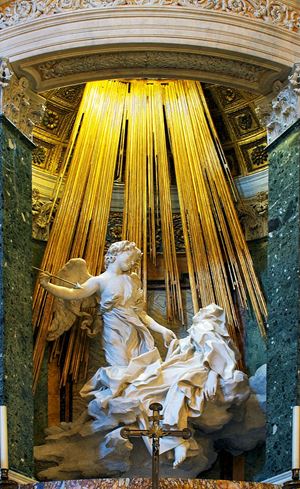
Paul Rubens “Teresa d’Avila”
Teresa of Jesusthe reformer of Carmelis the first woman in history to be recognized with the title of Doctor of the Church. Born in Avila in 1515, educated religiously by her parents, while still a young girl she became so passionate about reading the lives of the saints that she felt driven to escape secretly with her little brother Rodrigo towards «land of the Moors» to die as a martyr.
Brought home by her uncle who surprised her at the gates of Avila, she began to imitate the life of the desert hermits. Educated by the Augustinians of the monastery of Santa Maria di Grazia, she left for health reasons in 1532 and three years later decided to enter the Carmelite nuns of the Incarnation in Avila, but since her father had opposed it, she ran away from home and , welcomed into that monastery, after a year of postulancy she received the habit and took her vows on 3 November 1537.
Then struck by another serious illness which, after various vicissitudes, left her paralyzed for three years, in August 1542 she obtained a complete recovery, which she attributed to Saint Joseph of whom she was a fervent devotee.
In 1554, when she was almost forty years old, Jesus made her experiment, flooding her with interior graces and also with visions and raptures (including several times the grace of “transverberation”), that he was «truly God and «truly man» and that, by abandoning oneself to Him with all one’s heart, it was possible to love God «with all one’s heart, soul and strengths” and receive everything else as a gift from Him.
From the “convent” to eighteen monasteries
In 1560, after having had the famous vision of hell following which he had made the “vow of the most perfect”, Teresa accepted the pressing advice of some sisters who asked her to found a “small convent” in which the primitive Rule was followed perfectly.
Supported by some scholars and by Saint Peter of Alcantara, on 24 August 1562 she inaugurated the small monastery of Saint Joseph with the investiture of the first four novices. He remained there for five years, during which he drafted the constitutions, then had to leave for other foundations requested by the bishops or nobles of various cities, encouraged in this by the General of the Carmelites, Father Giovanni Battista de’ Rossi. Upon his death he will leave behind eighteen perfectly organized monasteries.

Gian Lorenzo Bernini, “Ecstasy of Saint Teresa”, Church of Santa Maria della Vittoria, Rome
THE’last monastery in Burgos
A woman with great vision, in order to have religious capable of guiding her nuns in their spiritual life, she thought of introducing the reform also among the Carmelites.
He succeeded, with the permission of his superiors and the help of Saint John of the Cross.
However, he had to interrupt his travels to take up the priory of his ancient monastery of the Incarnation where relaxation was growing. With the help of John of the Cross, confessor of the community, treating the nuns with gentleness and moderation, he succeeded and at the end of his mandate he resumed his travels.
In the meantime, however, his activity had sparked a storm between the Mitigati (or Calzati) Carmelites and those of the strict Observance (the Scalzi). The chapter of the Order forced the latter to live in the Calzati convents, supported in this by the Nuncio Filippo Segawho had some leaders of the reform imprisoned (including John of the Cross), treating Teresa as a “restless and wandering woman”.
The struggle became so heated that Philip II intervened by having the question examined by four impartial councilors, who agreed with the Scalzi, who in 1580 were able to found an autonomous province, then obtaining from Clement VIII complete canonical separation. Having left the monastery of Toledo where she had been locked up, the saint resumed her foundations even though she was very ill.
The last convent she erected was that of Burgos, then she reached that of Alba de Tormes where she died on 4 October 1582 (the next day, due to the Gregorian correction of the calendar, became October 15) in the arms of his secretary, the Blessed Anna of Saint Bartholomew, after an ecstasy that lasted 14 hours. His body remained incorrupt and flexible for a long time. Paul V beatified her in 1614 and Gregory XV canonized her on 12 March 1622.
The Inner Castle is one of the masterpieces of mystical literature
Teresa left numerous writings, the most important of which are:Autobiography, composed in 1562 out of obedience to the confessor and defined by her as “the book of the Lord’s mercies”; the Path of Perfection, in which he explains the way in which an entire community can be educated; the Foundations, history of the various “dovecotes of the Virgin”, as she used to call her monasteries; The Interior Castle or Book of the Seven Mansionsconsidered his masterpiece and one of the pinnacles of mystical literature. In it man is described as a castle in whose “profound center” God himself lives: a castle that, at times, seems uninhabited because man has been reduced to living outside, like a beggar; but it is enough to cross the threshold (the “door”, which is prayer for everyone) to find the possibility of crossing all the innumerable and wonderful “dwellings of the Castle”, until reaching God himself.
The brochure is also worth mentioning Thoughts on the Love of Godascetic-mystical commentary on some verses of the Canticle which frequently occur in the liturgy; subsequently burned by the saint on the orders of her father Yanguas who could not approve of women “writing on the Holy Scripture”, it has come down to us through the care of her daughters who had hidden and multiplied the copies.
In 1970 proclaimed Doctor of the Church
We also have about the saint left 400 letters to every category of people. On 10 September 1965, Paul VI proposed her as the patroness of Spanish Catholic writers and, on 27 September 1970 the Pontiff himself proclaimed her Doctor of the Church. A few days later, the same recognition was also given to Saint Catherine of Siena.
Teresa’s doctrine, the fruit of her readings and contacts with the greatest theologians and saints of her time in Spain, however comes in a special way from her mystical experience. It is a charism of science and wisdom with which, under the action of the Holy Spirit, she managed to glimpse and describe the mysterious work of God in the baptized person who abandons himself completely to his sanctifying dynamism.
That the works of the saint of Avila are perfectly inserted into the purest Catholic doctrine is demonstrated by the continuous editions of her writings: consider that only from 1900 to 1967 528 editions appearedi of his complete or partial works, a sign that they respond to the needs of modern man.









